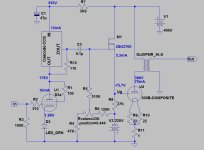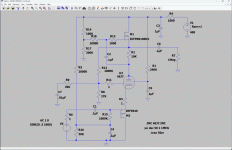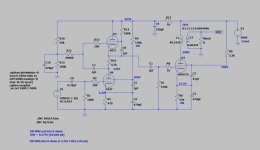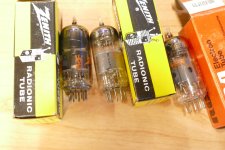I’m working on a 6sl7 front end, and with the extremely low current i can’t use the normal 10 M 45 that I would in most cases. B+is around 360 V, with 100k plate resistor. I have a bunch of the 2sk2700 fets that were used in the first tubelab se, can I just use the follower section without the CCS? Any problems I should be aware of?
The reason I ask is because it’s for a 45 amp, and I have never used a 6SL7, preferring normally tubes that draw much more current. But always doing the same thing becomes boring after a while.🫣😅
I’ve heard anecdotal reports that a 6sl7 driving a 45 sounds just fine, but I’m concerned about slew rate and driving capability. It’s a pretty weak tube to drive a DHT…..
I’ve heard anecdotal reports that a 6sl7 driving a 45 sounds just fine, but I’m concerned about slew rate and driving capability. It’s a pretty weak tube to drive a DHT…..
Yes, that’s very similar to what I normally use. But keep in mind, your D3 tube is drawing 10 mA. A 6sl7 tube operates between 1 to 2 ma. Normally.
But it's not driving a DHT, it's driving a source follower which has minimal input capacitance. The follower is doing the hard work, so there is really no slew-rate issue.I’m concerned about slew rate and driving capability. It’s a pretty weak tube to drive a DHT…..
What I meant was, I was concerned about the slew rate of just the 6sl7 driving the 45 tube. Of course with a follower that’s not an issue. My question was is there anything to watch our for using a fet follower in conjunction with a resistance coupled 6sl7?
With 360V and a 100k load into a follower you should have no trouble getting 100Vpk (way more than you need) provided the input resistance to the FET is large (R5 in Euro's schematic -larger than the 10k in George's original schematic).What I meant was, I was concerned about the slew rate of just the 6sl7 driving the 45 tube. Of course with a follower that’s not an issue. My question was is there anything to watch our for using a fet follower in conjunction with a resistance coupled 6sl7?
A 45 in cathode bias is easy to drive for a 6SL7, even without a follower. "DHTs are hard to drive, man" is a bit of an old wive's tale; their Miller capacitance isn't that big, really.
Last edited:
I had originally planned on not using a follower, but then considered the driving capability of the 6sl7 and decided that it would be a good idea.
When i have previously built circuits using a follower I had always used a CCS on the on the input tube, my question is, is there anything I need to take into a account when using the same follower with a 6sl7 with a plate resistor? Or is there absolutely no difference.
When i have previously built circuits using a follower I had always used a CCS on the on the input tube, my question is, is there anything I need to take into a account when using the same follower with a 6sl7 with a plate resistor? Or is there absolutely no difference.
Thank you, Merlin! That’s exactly what I wanted to know. It’s been a rough couple of weeks and my brain is not functioning properly, I thought I would double check before I began. Thank you for your expertise. then I shall proceed with soldering!
It's fine, the follower doesn't 'know' or care if there is a CCS beforehand.is there anything I need to take into a account when using the same follower with a 6sl7 with a plate resistor? Or is there absolutely no difference.
That is similar to the circuit used in the TSE and TSE-II. It works fine at currents in the 5+ mA range. The 10M45 can be iffy at low currents. Some work fine, but some exhibit quite a bit of variance over temp at low currents.More than a decade I use this version in my D3a, SF, 300B SE without any problem.
View attachment 1351589
A pentode will work fine into a resistive load, and a pure resistor can be used in place of the CCS, provided you can get enough gain out of the pentode to drive the output tube into clipping with your intended source. The follower does not know what feeds it. It's purpose is to provide a low impedance drive source to the output tube without loading down the driver, and to eliminate blocking distortion caused by grid current in the output tube affecting the DC charge in the coupling cap.
There is another option. While experimenting with ultra high gain pentode stages for guitar amp use, I got the idea to apply UNSET technology to a circuit that I used in a guitar amp for the Hundred Buck Amp challenge several years ago. I called that circuit the Saturator since it could be driven to total saturation from an electric guitar's signal. I simply called this circuit the UNSETURATOR. It can make lots of gain at very low THD and has been used successfully in testing for the next version of the UNSET amp, which I'm still working on. This is an Unseturator stage driving a TV sweep pentode in UNSET configuration.
See posts #110 - 114 and 119 here:
https://www.diyaudio.com/community/...he-way-i-always-wanted-to-do-it.410333/page-6
Also posts #173 and 175 here, with the next UNSET test amp pictured in post #210
https://www.diyaudio.com/community/threads/tubelab-wants-a-new-guitar-amp.408097/page-9
Circuit schematic is included.
If you are really interested in experimenting, you could build a CCS with a tube, or even use it as a "gyrator." The second schematic only exists as a simulation, I have not built it yet. It is intended for a guitar amp using all metal tubes, called MetallicAmp.
Attachments
The 6EJ7/ EF184 is one of the few TV IF amp tubes that is available worldwide. I was a TV repairman from 1969 through 1971 when these tubes first appeared in TV sets. The US made 6EJ7's and European EF184's were not the same and some US made TV sets would oscillate if a European made tube was installed. The shop where I worked was a Philco / Ford factory authorized shop, so we got all the factory service notes. Their answer was to use ONLY Philco branded replacement tubes. Sylvania was selling European made tubes in the US with both numbers on them.I also am a big fan of the 6ej7…
There are several other tubes with identical pinouts, and I make sure that my designs work with all of them. I bought a large lot of bulk packed GT BRITAIN labeled 6KT6's that are counterfeit. The outer packing boxes are covered in oriental characters, but the tubes are marked " 6KT6 GT BRITAIN." Who knows what they really are as the curves don't match any other 6KT6's that I have, but they work in my circuits.
I have noticed quite a bit of variation in the EF 184s, they either work great, or they don’t work at all, it seems they’re also very prone to shorts. I’ve looked at a few under heavy magnification, and the frame grid does look extremely fragile, I’m assuming that a few good kicks from the postman and things go south real quick. but I’ve used them quite a bit and single in it and push pull amps, and they basically do everything well. I’ve also lately been using the some unnamed East German postal tubes, a little bit less amplification, factor, but great tubes!
I lived in the U.S. for 30 years, and I must admit I had never seen an American made 6ej7, only the European versions. Of course branded Sylvania, or RCA and so on……
The two non-identical Zenith branded tubes both claim US origin. The tube on the left looks like it was made by Sylvania, but the middle tube is made by GE as it wears the tell tale date code dot pattern. The RCA branded tube on the right is made in Canada.
Attachments
- Home
- Amplifiers
- Tubes / Valves
- Help me George!! Powerdrive without the CCS?



